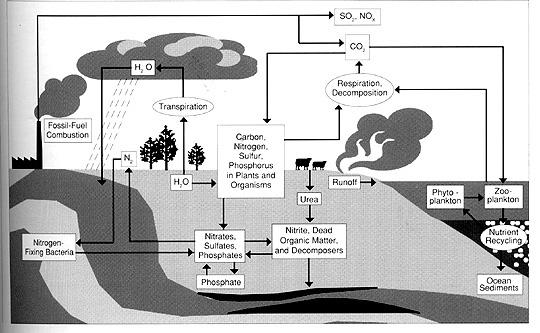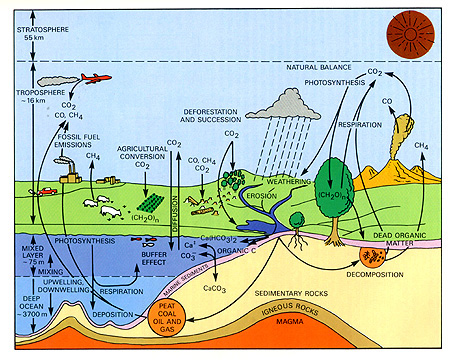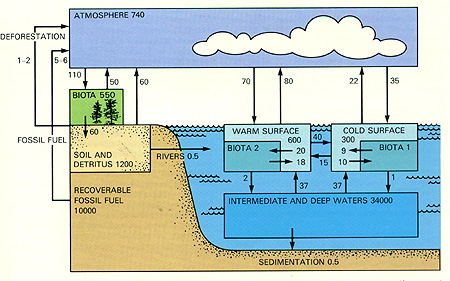

One of the classic diagrams supporting Earth System Science relates fluid and biological Earth processes that operate between the physical climate system and the biogeochemical system, receiving external energy inputs from the Sun and Earth's internal heat and being affected by human activities. We present a simplified version, known as the Bretherton Diagram, below.

We invite you to peruse this diagram to gain a feel for how these processes, driven by energy, climate, biogeochemistry, and human activities, interrelate.
16-11: What are the main drivers or controllers of these processes? ANSWER
Next, we summarize biogeochemical cycles, which depict the flow of important elements and compounds within the ecosystem as conveyed by biological and (geo)physical processes:

16-12: Do you believe everything you see in the above diagram is correct (sufficient connections)? ANSWER
One of the key cycles is that of the migrating and locating of carbon. Other geochemical element-based cycles include oxygen, nitrogen, phosphorus, sulphur, and iron. The next diagram outlines the main constituents (carbon and its compounds), and where they reside at any time within the four spheres. We find carbon in the solid Earth mainly in limestones and in petroleum and gas deposits.

Information on the mass balances within the carbon cycle has been obtained with fair reliability. We depict here the exchange of carbon, in units of 1015 g C yr-1, among the major reservoirs.

Carbon dioxide is a critical component in this cycle, being free in the atmosphere, dissolved in the oceans, integral in plant cells, and locked into sediments (limestones).
16-13 Checking the above diagram, what is the main "source" (returning CO2 to the active environment) and the main "sink" (receiving and storing the CO2) in the carbon geochemical cycle in today's world? ANSWER
From the above, we sense that Earth System Science deals primarily with matters of climatology and atmospheric physics/chemistry, as influenced by essential interactions with the ocean reservoir, water partitioning on the land, biological intakes and effluents, and particles and gases released from volcanoes. Unlike Landsat and similar programs, the emphasis of Earth System Science and its supporting EOS programs has shifted from solid Earth and land use to the environment. If you wish to learn more about the major study fields in Earth System Science, check the Foreword and first seven chapters in the EOS Science Strategy Report (http://eospso.gsfc.nasa.gov/sci_strategy/Foreword.html).
Accelerated global change is, by definition, a global problem. In addition, as we already noted with the example of the SO2 aerosol generated by Mount Pinatubo. What happens in any region of our planet may affect many other regions. How, then, do we address and keep checking on these global concerns?
As we shall see later in this Section, the entire field of Earth Systems Science is at the heart of a huge, multinational effort to use space platforms to monitor the Earth's atmosphere, oceans, biosphere, and active geosystems on the land. As part of that complex program, NASA has inaugurated as series of low cost, quick development satellite-based missions that go under the name Earth System Science Pathfinder (ESSP). Beginning in 2000, one to two launches per year will be highly focused on a single problem. Each mission will be run by the organization that "wins" in the semi-annual Announcement of Opportunity. That organization (be it public or private) will be funded to design, manage, and interpret the mission program, with help from NASA. The first two mission selected are code-named VCL and GRACE. You can learn more about this program on its Home Page at ESSP.

Primary Author: Nicholas M. Short, Sr. email: nmshort@epix.net
Collaborators: Code 935 NASA GSFC, GST, USAF Academy
Contributor Information
Last Updated: September '99
Webmaster: Bill Dickinson Jr.
Site Curator: Nannette Fekete
Please direct any comments to rstweb@gst.com.